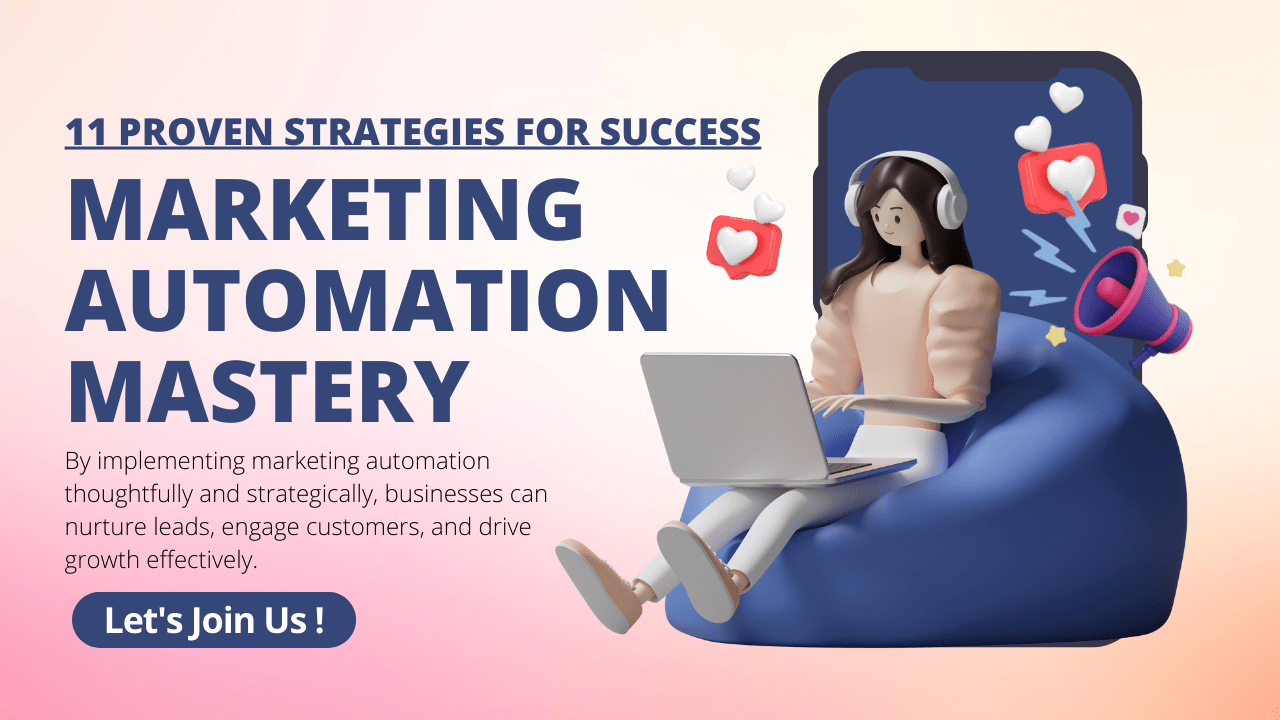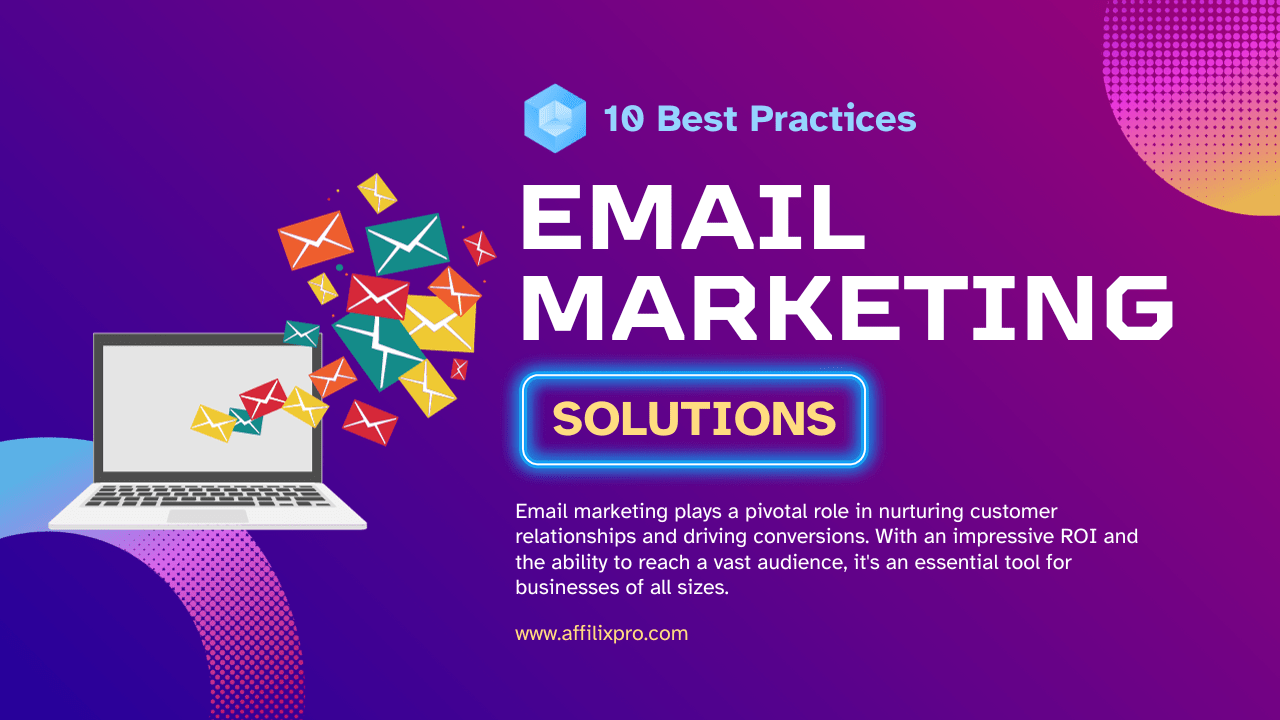Marketing Automation Mastery: 11 Proven Strategies
In the rapidly evolving landscape of digital marketing, businesses are constantly seeking innovative ways to streamline their marketing efforts and drive better results. Enter marketing automation – a powerful strategy and technology that has transformed the way companies engage with their audience and manage their marketing campaigns.
Marketing automation tools have revolutionized the way businesses approach their marketing strategies. In this article, we will explore how these tools can streamline your marketing efforts and boost your ROI.

What is Marketing Automation?
Marketing automation refers to the use of software and technology to automate repetitive marketing tasks and processes. These tasks can include email marketing, social media posting, lead nurturing, and more. The primary goal of marketing automation is to increase efficiency, improve targeting, and enhance the overall effectiveness of marketing efforts.
At its core, marketing automation is about delivering the right message to the right audience at the right time. Instead of manually sending out emails or posting on social media at specific times, marketing automation tools use data and algorithms to trigger these actions automatically. This not only saves time but also ensures that marketing messages are delivered when they are most likely to resonate with the audience.
Benefits of Marketing Automation
1. Enhanced Personalization
Marketing automation allows businesses to create highly personalized marketing campaigns. By analyzing customer data and behavior, these tools can tailor messages and content to individual preferences, increasing the chances of conversion.
2. Improved Lead Nurturing
Lead nurturing is a critical part of the customer journey. Marketing automation enables businesses to nurture leads through automated email sequences, ensuring that leads are engaged and educated until they are ready to make a purchase.
3. Increased Efficiency
Automation eliminates the need for manual, time-consuming tasks. This means marketing teams can focus on strategic activities, such as content creation and campaign optimization, rather than repetitive chores.
4. Scalability
Marketing automation tools can scale with your business. Whether you’re a small startup or a large enterprise, these tools can adapt to your needs and grow with you.
5. Data-Driven Insights
Marketing automation provides valuable insights into campaign performance. You can track key metrics, measure ROI, and make data-driven decisions to refine your marketing strategy.
Evolution of Marketing Automation
Marketing automation has come a long way since its inception. Initially, it was primarily used for email marketing automation. However, it has evolved into a multifaceted approach encompassing various marketing channels, including social media, content marketing, and more.
As technology continues to advance, marketing automation tools are incorporating artificial intelligence and machine learning capabilities. These advancements enable even more sophisticated targeting and personalization, making marketing automation an indispensable part of modern marketing strategies.
In the following sections of this article, we’ll delve deeper into the various types of marketing automation tools, their key features, and how to choose the right one for your business. Whether you’re a seasoned marketer or just getting started, understanding marketing automation is essential for staying competitive in today’s digital landscape.

Types of Marketing Automation Tools
Marketing automation is a versatile strategy that encompasses a wide range of tools and platforms, each designed to streamline and enhance specific aspects of marketing campaigns. Here are some of the key types of marketing automation tools:
1. Email Marketing Automation
Definition: Email marketing automation tools are designed to automate and optimize email campaigns. They enable businesses to send personalized and targeted emails to their subscribers at the right time, increasing engagement and conversion rates.
Key Features:
- Segmentation: Divide your email list into segments based on various criteria (e.g., demographics, behavior) to send tailored messages.
- Autoresponders: Set up automated email sequences triggered by specific actions or events.
- A/B Testing: Test different email content and subject lines to determine what resonates best with your audience.
- Drip Campaigns: Send a series of pre-scheduled emails to nurture leads over time.
Popular Tools: Mailchimp, HubSpot Email Marketing, Brevo.
2. Social Media Marketing Automation
Definition: Social media marketing automation tools help manage and schedule social media posts across various platforms. They enable businesses to maintain a consistent online presence and engage with their audience effectively.
Key Features:
- Content Scheduling: Plan and schedule posts in advance, ensuring a steady flow of content.
- Social Listening: Monitor social media channels for mentions of your brand or relevant keywords.
- Analytics: Track engagement metrics and analyze the performance of your social media campaigns.
Popular Tools: Hootsuite, Buffer, Sprout Social.
3. Content Marketing Automation
Definition: Content marketing automation tools assist in content creation, distribution, and optimization. They help businesses streamline their content marketing efforts and improve their content’s reach and impact.
Key Features:
- Content Calendar: Plan and organize content creation and publication schedules.
- Content Optimization: Suggest improvements for SEO and readability.
- Content Distribution: Automate content sharing on various platforms and channels.
Popular Tools: CoSchedule, SEMrush.
4. Customer Relationship Management (CRM) Systems
Definition: CRM systems are essential for managing customer interactions and data. While not exclusive to marketing, they play a crucial role in marketing automation by providing insights into customer behavior and preferences.
Key Features:
- Contact Management: Store and organize customer information and communication history.
- Lead Scoring: Assign scores to leads based on their engagement and behavior.
- Sales Funnel Tracking: Monitor leads as they move through the sales pipeline.
Popular Tools: Salesforce, HubSpot CRM, Zoho CRM.
5. Analytics and Reporting Tools
Definition: Analytics and reporting tools provide insights into the performance of your marketing campaigns. They help you track key metrics, measure ROI, and make data-driven decisions.
Key Features:
- Data Visualization: Present data in visually compelling formats such as charts and graphs.
- Conversion Tracking: Monitor conversions and attribute them to specific marketing efforts.
- Custom Reporting: Create custom reports tailored to your business’s unique KPIs.
Popular Tools: Google Analytics, Adobe Analytics, Domo.
These are just a few examples of the types of marketing automation tools available. Depending on your business’s goals and needs, you may use a combination of these tools to create a comprehensive marketing automation strategy. In the following sections, we will delve deeper into the key features of these tools and how to choose the right ones for your specific marketing objectives.

Key Features of Marketing Automation Tools
Marketing automation tools offer a wide array of features to streamline and enhance your marketing efforts. These features empower businesses to automate tasks, personalize communications, and optimize campaigns for better results. Here are some of the essential key features of marketing automation tools:
1. Lead Scoring
Definition: Lead scoring is a mechanism that assigns numerical values to leads based on their behavior and engagement with your marketing content. It helps you prioritize leads and focus your efforts on those most likely to convert into customers.
How It Works:
- Leads are assigned scores based on actions like opening emails, clicking on links, visiting specific web pages, or filling out forms.
- Higher scores indicate leads that are more engaged and closer to making a purchase.
- Allows sales teams to prioritize and target leads effectively.
Benefits:
- Efficient allocation of resources, ensuring sales teams focus on high-potential leads.
- Improved conversion rates as leads receive more relevant and timely communication.
2. Drip Campaigns
Definition: Drip campaigns are automated email sequences sent to leads or customers over a predetermined period. These campaigns are designed to nurture leads and guide them through the sales funnel.
How It Works:
- Drip campaigns deliver a series of pre-scheduled emails to leads at specific intervals.
- Each email in the sequence provides valuable information, educates the lead, and encourages them to take the next step.
- Drip campaigns can be customized based on lead behavior and preferences.
Benefits:
- Consistent and personalized communication with leads.
- Gradual lead nurturing, increasing the likelihood of conversion.
3. Workflow Automation
Definition: Workflow automation allows you to create and automate marketing processes, reducing manual tasks and ensuring that marketing operations run smoothly.
How It Works:
- Define a series of actions and conditions that determine how leads are managed and communicated with.
- Examples include sending a welcome email to new subscribers, notifying sales teams when a lead reaches a specific score, or automating follow-up emails based on lead behavior.
Benefits:
- Saves time and reduces the risk of human error.
- Ensures a consistent and efficient response to various lead interactions.
4. A/B Testing
Definition: A/B testing, also known as split testing, is a method to compare two versions of a marketing asset (e.g., an email, landing page) to determine which one performs better.
How It Works:
- Create two variations (A and B) of a marketing element with one distinct difference (e.g., subject line, call-to-action).
- Send both versions to separate segments of your audience.
- Analyze the performance data to determine which version generates better results.
Benefits:
- Data-driven optimization of marketing assets.
- Continuous improvement of campaigns for higher conversion rates.
5. Personalization
Definition: Personalization involves tailoring marketing content and communication to individual leads or customers based on their preferences, behavior, and demographics.
How It Works:
- Use customer data to personalize emails, content recommendations, and product offerings.
- Personalization can extend to website content, dynamically displaying relevant information to each visitor.
Benefits:
- Higher engagement and conversion rates as customers receive content and offers that resonate with their interests.
- Enhanced customer satisfaction and loyalty due to personalized experiences.
6. Integration Capabilities
Definition: Integration capabilities enable marketing automation tools to connect and share data with other software and platforms, such as CRM systems, email marketing platforms, and e-commerce platforms.
How It Works:
- Integrations facilitate the seamless flow of data between different systems, eliminating the need for manual data entry and ensuring data consistency.
- For example, a marketing automation tool can integrate with a CRM system to sync lead and customer data.
Benefits:
- Centralized data management and improved data accuracy.
- Streamlined processes and enhanced collaboration between marketing and sales teams.
These key features empower marketers to automate and optimize their campaigns, saving time, increasing efficiency, and delivering more personalized experiences to leads and customers. When selecting a marketing automation tool, consider the presence and capabilities of these features to ensure it aligns with your marketing goals and strategies.

Choosing the Right Marketing Automation Tool
1. Assessing Your Business Needs
Before diving into the world of marketing automation tools, it’s essential to have a clear understanding of your business’s unique needs and goals. Consider the following factors:
a. Marketing Objectives
- What are your primary marketing objectives? (e.g., lead generation, customer retention, brand awareness)
- Do you have specific KPIs in mind that you want to achieve with automation?
b. Target Audience
- Who is your target audience? (e.g., B2B or B2C, demographics, industry)
- Do you need to segment your audience for more personalized communication?
c. Existing Technology Stack
- What other tools and systems are currently in use within your organization? (e.g., CRM, email marketing software)
- Does the marketing automation tool need to integrate with these systems?
d. Budget
- What is your budget for marketing automation?
- Are you willing to invest in a more advanced solution with a higher price point, or do you need a more cost-effective option?
e. Team Expertise
- What is the skill level of your marketing team when it comes to using marketing automation tools?
- Do you need a tool with a user-friendly interface and comprehensive training resources?
2. Scalability
Consider the scalability of the marketing automation tool. Ensure that it can grow with your business as your needs evolve. Look for:
- Options to upgrade or add features as your business expands.
- The ability to handle an increasing volume of leads and contacts.
- Compatibility with your growth strategy.
3. User-Friendliness
A user-friendly interface is essential, especially if your marketing team has varying levels of technical expertise. Look for:
- An intuitive dashboard and navigation.
- Clear and easily accessible support and documentation.
- Training resources and customer support options.
4. Customer Support and Training
Evaluate the customer support and training options offered by the marketing automation tool provider. Consider:
- Availability of customer support (phone, chat, email).
- Comprehensive documentation, FAQs, and tutorials.
- Training programs or onboarding assistance.
5. Integration Capabilities
Ensure that the marketing automation tool can seamlessly integrate with your existing software stack. Look for:
- Pre-built integrations with common platforms (e.g., CRM systems, email marketing software).
- An open API that allows custom integrations if necessary.
- Compatibility with your preferred data formats and protocols.
6. Reporting and Analytics
Robust reporting and analytics are crucial for tracking the performance of your marketing campaigns. Seek:
- Advanced reporting features, including customizable dashboards.
- Real-time data tracking and visualization.
- Integration with third-party analytics tools if needed.
7. Compliance and Security
Consider the tool’s compliance with data protection regulations (e.g., GDPR, CCPA) and its security measures. Ensure that:
- Customer data is protected and encrypted.
- The tool provides features to help you comply with relevant regulations.
- There is a transparent data handling policy.
8. Trial Period
Whenever possible, take advantage of a trial period or a free version of the tool to test its functionality and suitability for your business before committing to a subscription.
9. Customer Reviews and References
Research customer reviews and request references from the marketing automation tool provider. Feedback from other users can provide valuable insights into the tool’s strengths and weaknesses.
10. Cost Analysis
Finally, conduct a thorough cost analysis, taking into account not only the subscription fees but also potential additional costs for training, integrations, and upgrades. Ensure that the tool provides a good return on investment (ROI) for your specific marketing goals.
By carefully considering these factors, you can select a marketing automation tool that not only meets your current needs but also positions your business for future growth and success. Remember that the right tool can significantly enhance your marketing efficiency and effectiveness.

Implementing Marketing Automation
1. Setting Up Your Account
a. Select the Right Tool
Before you start the implementation process, ensure that you’ve chosen the right marketing automation tool that aligns with your business goals and needs, as discussed in the previous section.
b. Create User Accounts
Set up user accounts for your marketing team members who will be using the automation tool. Assign roles and permissions based on their responsibilities and access requirements.
2. Data Integration
a. Data Collection and Cleaning
Collect and clean your customer and lead data. Ensure that it is accurate, up-to-date, and organized. This may involve merging duplicate records, validating email addresses, and enriching data with additional information.
b. Integration with Existing Systems
Integrate the marketing automation tool with your existing systems, such as CRM software, email marketing platforms, and e-commerce solutions. A seamless flow of data between these systems is essential for a holistic view of customer interactions.
c. Data Mapping
Map data fields from your various sources to ensure that information is transferred correctly. This step is critical for maintaining data integrity.
3. Building Contact Lists
a. Segmentation
Segment your contact lists based on criteria such as demographics, behavior, and engagement level. Segmentation allows for more personalized and targeted marketing campaigns.
b. Importing Contacts
Import your cleaned and segmented contact lists into the marketing automation tool. Most tools provide easy-to-use import features.
c. Consent and Compliance
Ensure that you have the necessary permissions and consent to communicate with your contacts, especially with regard to email marketing. Comply with data protection regulations like GDPR or CAN-SPAM.
4. Creating Campaigns
a. Content Creation
Prepare the content for your marketing campaigns, including emails, landing pages, and social media posts. Ensure that the content aligns with your marketing objectives and is tailored to your target audience.
b. Campaign Workflows
Design automated workflows that define the customer journey. Specify triggers (e.g., form submissions, website visits) and actions (e.g., sending emails, assigning lead scores) within these workflows.
c. Personalization
Leverage personalization features to tailor your messages to individual contacts. Use dynamic content, merge tags, and behavioral triggers to enhance personalization.
5. Testing
a. A/B Testing
Before launching campaigns, conduct A/B tests to determine which elements (subject lines, email content, calls to action) perform best. Optimize based on test results.
b. Workflow Testing
Test your automated workflows to ensure that triggers and actions function as intended. Address any issues or inconsistencies.
6. Launching Campaigns
Schedule and launch your marketing campaigns according to your defined workflows. Ensure that campaigns are sent at optimal times to maximize engagement.
7. Content Creation and Scheduling
Utilize the marketing automation tool to create and schedule content across various channels, such as email, social media, and blogs. Maintain a consistent content calendar for effective communication.
8. Monitoring and Optimization
Regularly monitor campaign performance using the analytics and reporting features of your marketing automation tool. Analyze key metrics, such as open rates, click-through rates, and conversion rates, to identify areas for improvement.
Based on data insights, make necessary adjustments to your campaigns and workflows to improve their effectiveness. This may involve tweaking messaging, adjusting timing, or refining segmentation.
9. Compliance with Regulations
Ensure ongoing compliance with data protection regulations and industry-specific guidelines. Keep up to date with any changes in regulations and adjust your practices accordingly.
10. Training and Support
Provide training and support to your marketing team to ensure they fully utilize the marketing automation tool’s capabilities. Encourage ongoing learning and exploration of new features.
11. Performance Evaluation
Regularly assess the ROI and overall impact of your marketing automation efforts. Evaluate whether your objectives are being met and adjust your strategies accordingly.
12. Scaling and Expansion
As your business grows, consider scaling your marketing automation efforts. This may involve adding more advanced features, expanding into new channels, or integrating additional tools to support your evolving needs.
By following this comprehensive implementation process, you can effectively leverage marketing automation to streamline your marketing efforts, engage your audience more effectively, and achieve your marketing objectives. It’s an ongoing journey of refinement and optimization that can lead to significant improvements in your marketing outcomes.

Best Practices for Marketing Automation
Marketing automation can be a powerful tool, but its effectiveness depends on how well it is implemented and managed. To maximize the benefits of marketing automation, consider the following best practices:
1. Define Clear Objectives
Before diving into automation, establish clear marketing objectives. What do you want to achieve with automation? Whether it’s lead generation, lead nurturing, customer retention, or something else, having well-defined goals will guide your automation efforts.
2. Segment Your Audience
Effective segmentation is at the core of successful marketing automation. Divide your audience into distinct segments based on factors like demographics, behavior, and engagement. This enables you to send targeted, relevant messages to each group.
3. Map the Customer Journey
Understand your customers’ journey from awareness to conversion and beyond. Create workflows that align with each stage of the journey. Tailor your messaging to provide value and guide leads seamlessly through the funnel.
4. Personalize Content
Personalization is key to engagement. Use data to customize emails, website content, and offers based on individual preferences and behavior. Personalized content is more likely to resonate with your audience and drive conversions.
5. Nurture Leads
Lead nurturing is a fundamental aspect of marketing automation. Create automated drip campaigns that deliver timely and relevant content to leads as they progress through the sales funnel. Gradually build trust and credibility.
6. Implement Lead Scoring
Lead scoring helps you prioritize leads based on their level of engagement and readiness to buy. Assign scores to actions like email opens, website visits, and form submissions. Focus your efforts on high-scoring leads.
7. Monitor and Analyze Data
Regularly monitor campaign performance and analyze data. Track key metrics such as open rates, click-through rates, conversion rates, and ROI. Use these insights to refine your strategies and optimize your automation workflows.
8. A/B Test Campaigns
A/B testing is a powerful tool for optimization. Test different elements of your campaigns, such as subject lines, email content, and calls to action. Use the results to make data-driven improvements.
9. Multichannel Marketing
Expand your automation efforts beyond email. Incorporate other channels such as social media, SMS, and webinars to reach your audience where they are most active. Ensure consistent messaging across channels.
10. Compliance and Data Security
Adhere to data protection regulations like GDPR, CAN-SPAM, and CCPA. Obtain explicit consent for communication and provide opt-out options in emails. Safeguard customer data with robust security measures.
11. Integrate with CRM
Integrate your marketing automation tool with your CRM system for seamless data exchange. This integration ensures that sales and marketing teams have access to up-to-date customer information.
12. Test Automation Workflows
Before launching automated workflows, thoroughly test them to ensure they function as intended. Verify that triggers, actions, and conditional logic work correctly to deliver a smooth customer experience.
13. Training and Education
Invest in training and education for your marketing team. Ensure that team members are proficient in using the automation tool’s features to their full potential.
14. Optimize for Mobile
Given the prevalence of mobile devices, ensure that your automated emails and landing pages are mobile-responsive. Test your content on various devices and screen sizes to guarantee a seamless mobile experience.
15. Regularly Review and Update
Marketing automation is not a set-and-forget solution. Regularly review and update your automation workflows, content, and strategies to adapt to changing customer behaviors and industry trends.
16. Measure ROI
Ultimately, measure the return on investment (ROI) of your marketing automation efforts. Calculate the revenue generated versus the costs incurred. This data will help justify your automation budget and guide future decisions.
By following these best practices, you can harness the full potential of marketing automation to drive engagement, conversions, and customer loyalty. Marketing automation, when implemented effectively, can be a valuable asset in your digital marketing arsenal.

Measuring Success with Marketing Automation
1. Define Key Performance Indicators (KPIs)
Identify the specific Key Performance Indicators (KPIs) that align with your marketing objectives and goals. Common KPIs for marketing automation include:
- Conversion Rate: The percentage of leads that take a desired action, such as making a purchase or filling out a form.
- Click-Through Rate (CTR): The percentage of recipients who clicked on a link or call to action in your emails.
- Open Rate: The percentage of email recipients who opened your email.
- Lead Generation: The number of new leads generated through your campaigns.
- ROI (Return on Investment): The revenue generated compared to the cost of your marketing automation efforts.
- Customer Retention Rate: The percentage of customers who continue to engage with your brand.
2. Track and Analyze Data
Utilize the tracking and analytics features of your marketing automation tool to monitor campaign performance. Regularly analyze data to gain insights into how your campaigns are performing. Key data points to track include:
- Conversion Paths: Trace the paths that leads follow from initial engagement to conversion. Identify which channels and touchpoints contribute most to conversions.
- Behavioral Data: Analyze how leads interact with your content and campaigns. Track actions like email opens, link clicks, website visits, and form submissions.
- Segmentation Data: Assess the effectiveness of your segmentation by analyzing engagement and conversion rates for different segments of your audience.
3. Set Benchmark Metrics
Establish benchmark metrics based on historical data or industry standards. These benchmarks serve as reference points to evaluate your current performance. Compare your KPIs to these benchmarks to assess whether you’re meeting, exceeding, or falling short of expectations.
4. Create Custom Reports and Dashboards
Leverage the reporting capabilities of your marketing automation tool to create custom reports and dashboards that display relevant data at a glance. Customization allows you to focus on the specific metrics that matter most to your goals.
5. ROI Tracking
Calculate the Return on Investment (ROI) for your marketing automation efforts. To do this, subtract the total cost of your automation tools, content creation, and other related expenses from the revenue generated through automation-driven conversions. A positive ROI indicates a successful automation campaign.
6. Monitor Conversion Rate
Evaluate the conversion rate of your marketing automation campaigns over time. Analyze whether it’s increasing, decreasing, or remaining steady. If you notice a decline, investigate potential reasons and make adjustments accordingly.
7. Customer Retention and Loyalty
Assess customer retention rates among your automated campaigns. Are customers who engage with automated content more likely to remain loyal? Calculate the lifetime value of customers acquired through automation to understand their long-term impact on your business.
8. Multichannel Attribution
Use multichannel attribution models to understand how different marketing channels contribute to conversions. This helps you allocate resources effectively and optimize your marketing mix.
9. A/B Testing Results
Review the results of A/B tests conducted within your automation campaigns. Identify which variations performed better and implement the winning elements in future campaigns.
10. Customer Feedback and Surveys
Gather customer feedback and conduct surveys to measure satisfaction and identify areas for improvement. Insights from your audience can inform your automation strategies and content creation.
11. Periodic Campaign Audits
Perform periodic audits of your automated campaigns. Assess their relevance, effectiveness, and alignment with current business goals. Make adjustments and updates as needed to keep campaigns fresh and engaging.
12. Competitive Analysis
Monitor the marketing automation efforts of competitors. Compare your performance to industry benchmarks and your rivals to identify areas where you can gain a competitive edge.
13. Iterate and Optimize
Marketing automation is an ongoing process. Continuously analyze data, identify areas for improvement, and iterate on your campaigns. Adjust strategies, content, and workflows based on your findings to achieve better results.
14. Report and Communicate Results
Regularly report the results of your marketing automation efforts to relevant stakeholders within your organization. Effective communication ensures that everyone is aligned and can contribute to optimization efforts.
By following these steps and regularly measuring the success of your marketing automation campaigns, you can fine-tune your strategies, improve ROI, and consistently achieve your marketing objectives. Marketing automation should be an agile and evolving component of your overall marketing strategy.

Case Studies
1. Identify Success Stories
Before you can create case studies, you need success stories to highlight. Look for instances where your marketing automation efforts have led to significant improvements, whether it’s increased leads, higher conversion rates, cost savings, or other measurable results.
2. Collect Data and Metrics
Gather data and metrics that illustrate the impact of your marketing automation campaigns. This may include statistics on lead generation, conversion rates, revenue increase, customer retention, or any other relevant KPIs. Accurate and comprehensive data is crucial for building a compelling case study.
3. Select the Right Format
Case studies can take various formats, including written reports, video testimonials, infographics, or interactive web pages. Choose the format that best suits your audience and the story you want to tell. Written case studies are versatile and can be used across different marketing channels, while video testimonials add a personal touch.
4. Structure the Case Study
A well-structured case study typically includes the following sections:
- Title: A concise and attention-grabbing title that summarizes the success story.
- Introduction: Provide context for the case study and introduce the business or individual featured.
- Challenge: Describe the problem or challenge the subject faced before implementing marketing automation.
- Solution: Explain how your marketing automation strategy addressed the challenge.
- Implementation: Detail the steps taken to implement the automation solution, including tools used, workflows created, and content developed.
- Results: Present the measurable outcomes and improvements achieved, using data and metrics.
- Testimonials: Include quotes or video clips from individuals within the organization, highlighting their experiences and satisfaction with the solution.
- Conclusion: Summarize the key takeaways and emphasize the success of the marketing automation strategy.
- Call to Action: Encourage the reader or viewer to take a specific action, such as contacting your team for assistance or exploring your automation solutions.
5. Highlight Real Numbers
Emphasize the quantifiable results achieved through marketing automation. Use graphs, charts, and statistics to illustrate the impact clearly. Real numbers lend credibility and provide a compelling reason for others to consider implementing similar strategies.
6. Tell a Compelling Story
Craft a narrative that engages the audience emotionally. Share the challenges faced by the subject and how they overcame them using your marketing automation solution. Storytelling adds a human element to the case study, making it relatable and memorable.
7. Include Visuals
Visual elements like images, graphs, and infographics enhance the readability and appeal of your case study. Visuals can simplify complex concepts and make data more digestible.
8. Provide Before-and-After Comparisons
Show the stark contrast between the situation before and after implementing marketing automation. This helps the audience understand the transformative power of your solution.
9. Make it Shareable
Create case studies that are easily shareable on social media and within your industry. Encourage your satisfied clients to share their success stories with their networks, amplifying the reach and impact of your case studies.
10. Integrate Case Studies into Your Marketing
Promote your case studies through various marketing channels, including your website, email newsletters, social media, and sales presentations. Use them to demonstrate your expertise and build trust with potential clients or customers.
11. Continuously Update and Expand
As you accumulate more success stories, regularly update and expand your library of case studies. Tailor case studies to different industry niches or specific challenges to appeal to a broader audience.
12. Collect Feedback
Encourage feedback from your audience to learn how case studies resonate with them and if there are any additional details or information they would find valuable.
Case studies serve as powerful marketing assets that provide social proof and tangible evidence of the effectiveness of your marketing automation services or solutions. By strategically creating and sharing case studies, you can inspire confidence in potential clients and demonstrate the value you bring to the table.

Challenges and Pitfalls
1. Complex Implementation
Challenge: Setting up marketing automation can be complex and time-consuming. Integrating various systems, importing and segmenting data, and creating automated workflows require technical expertise and careful planning.
Pitfall: Rushing through the implementation process without a clear strategy can lead to mistakes, data errors, and automation workflows that don’t align with business goals.
Solution: Invest time in planning and seek expert assistance when necessary. Prioritize a well-structured implementation plan to ensure a smooth transition.
2. Lack of Quality Data
Challenge: Marketing automation relies heavily on data, and inaccurate or incomplete data can hinder your efforts. Many businesses struggle with data quality issues, such as outdated or duplicate records.
Pitfall: Automating campaigns based on flawed data can lead to irrelevant messaging, poor personalization, and frustrated recipients.
Solution: Regularly clean and update your database. Implement data validation processes to ensure the accuracy of customer information.
3. Over-Automation
Challenge: It’s tempting to automate as much as possible, but over-automation can lead to a robotic, impersonal customer experience. Too many automated touchpoints can alienate customers.
Pitfall: Bombarding leads and customers with automated messages can result in unsubscribes, decreased engagement, and a negative brand perception.
Solution: Strike a balance between automation and human touch. Use automation for repetitive tasks but maintain opportunities for personalization and genuine human interaction.
4. Content Quality
Challenge: Creating high-quality, engaging content is essential for successful marketing automation. Maintaining a consistent stream of valuable content can be challenging.
Pitfall: Automating content that lacks relevance or value can lead to disengagement and unsubscribes.
Solution: Invest in content creation and strategy. Develop a content calendar that aligns with your automation workflows and customer personas.
5. Ignoring the Customer Journey
Challenge: Focusing solely on individual automation elements without considering the overall customer journey can result in disjointed and ineffective campaigns.
Pitfall: Customers may receive conflicting messages or experience gaps in their interactions with your brand.
Solution: Map out the entire customer journey and align automation workflows to deliver a seamless and consistent experience.
6. Failure to Segment Effectively
Challenge: Inaccurate or inadequate segmentation can lead to irrelevant messaging. It’s essential to segment your audience effectively based on behavior, demographics, and preferences.
Pitfall: Sending the same automated messages to all leads can result in low engagement and conversion rates.
Solution: Invest time in creating well-defined segments and tailor your automation workflows to each segment’s specific needs and preferences.
7. Neglecting Analytics
Challenge: Neglecting to monitor and analyze campaign performance can lead to missed opportunities for optimization and improvement.
Pitfall: Without data-driven insights, you may continue ineffective automation strategies, wasting resources.
Solution: Regularly review analytics data to identify areas for improvement. Adjust your automation strategies based on performance metrics.
8. Lack of Testing
Challenge: Failing to conduct A/B tests and experiments can limit your ability to refine and optimize automation workflows.
Pitfall: Without testing, you may miss opportunities to improve open rates, click-through rates, and conversion rates.
Solution: Implement A/B testing regularly to assess the effectiveness of different elements within your automation campaigns.
9. Ignoring Compliance
Challenge: Overlooking data protection regulations and email marketing laws can result in legal issues and damage your reputation.
Pitfall: Non-compliance can lead to fines and a loss of trust among customers.
Solution: Stay informed about relevant regulations, such as GDPR and CAN-SPAM, and ensure that your automation processes are compliant.
10. Failure to Adapt
Challenge: Markets, technologies, and consumer behavior are continually evolving. Failing to adapt your automation strategies can result in obsolescence.
Pitfall: Sticking with outdated automation methods can hinder your competitiveness and effectiveness.
Solution: Continuously monitor industry trends, stay updated on automation technology advancements, and be willing to adapt and evolve your strategies.
Navigating these challenges and pitfalls requires a thoughtful and strategic approach to marketing automation. By addressing these issues proactively and continually optimizing your automation strategies, you can maximize the benefits and long-term success of your automated marketing campaigns.

Future Trends in Marketing Automation
1. AI-Powered Personalization
Trend: AI and machine learning will play an increasingly prominent role in marketing automation. AI algorithms will enable highly personalized content recommendations and product suggestions, improving customer engagement and conversions.
Impact: Marketers will be able to deliver hyper-personalized experiences to individual customers, boosting customer loyalty and sales.
2. Predictive Analytics for Lead Scoring
Trend: Predictive analytics will become more sophisticated in identifying high-value leads. Machine learning models will analyze historical data and customer behavior to predict which leads are most likely to convert.
Impact: Sales teams will focus their efforts on leads with the highest conversion potential, resulting in improved conversion rates and resource allocation.
3. Chatbots and Conversational Marketing
Trend: Chatbots and AI-driven chat applications will continue to grow in popularity. They will facilitate real-time conversations with customers, guiding them through the sales funnel and providing instant support.
Impact: Enhanced customer engagement, reduced response times, and improved user experiences will be the outcomes.
4. Voice Search Optimization
Trend: With the rise of voice-activated devices and voice search, marketers will need to optimize content for voice search queries. Voice assistants like Siri, Alexa, and Google Assistant will become key touchpoints for consumers.
Impact: Businesses that adapt to voice search optimization will capture a growing audience and improve their online visibility.
5. Cross-Channel Orchestration
Trend: Marketers will increasingly leverage marketing automation platforms that offer seamless cross-channel orchestration. This will enable consistent messaging and customer experiences across various digital touchpoints, including email, social media, and websites.
Impact: Enhanced customer journeys and improved brand consistency will lead to higher engagement and conversion rates.
6. Video Marketing Automation
Trend: Video content will continue to dominate online engagement. Automation tools will offer features to create, personalize, and schedule video content as part of marketing campaigns.
Impact: Marketers can tap into the popularity of video content to engage audiences effectively and convey complex messages.
7. Ethical Data Handling
Trend: With increased scrutiny on data privacy and regulations like GDPR and CCPA, ethical data handling practices will become a crucial aspect of marketing automation. Businesses will focus on obtaining and using customer data transparently and responsibly.
Impact: Building trust with customers through ethical data practices will be vital in maintaining brand reputation and customer loyalty.
8. Augmented Reality (AR) and Virtual Reality (VR)
Trend: AR and VR technologies will find applications in marketing automation, allowing businesses to create immersive and interactive experiences for customers.
Impact: Enhanced product visualization, virtual showrooms, and immersive storytelling will set brands apart and drive engagement.
9. Automation for Customer Retention
Trend: Beyond lead generation, marketing automation will increasingly focus on customer retention strategies. Automated loyalty programs, re-engagement campaigns, and personalized post-purchase experiences will become more prevalent.
Impact: Improved customer retention rates and increased customer lifetime value will result from these efforts.
10. Compliance Automation
Trend: Automation tools will integrate compliance features to help businesses stay compliant with evolving data protection regulations. These features will streamline data consent management and reporting.
Impact: Reduced compliance risks and the ability to adapt to changing regulations seamlessly.
Keeping an eye on these future trends in marketing automation and proactively integrating relevant technologies and strategies into your marketing efforts will be key to staying competitive and effectively engaging with your target audience in the coming years. Adaptation and innovation will continue to be essential in the dynamic field of marketing automation.

Marketing Automation Tools Comparison
1. Identify Your Requirements
Before diving into the comparison, clearly define your requirements and objectives. Consider factors such as:
- Your budget for marketing automation.
- The size and nature of your target audience.
- Integration needs with existing software (e.g., CRM, email marketing).
- The complexity of your marketing workflows.
- Desired features (e.g., email marketing, lead scoring, A/B testing).
2. List Potential Tools
Compile a list of marketing automation tools that are known for serving businesses in your industry or with similar needs. Some popular marketing automation tools to consider include:
- HubSpot
- Adobe Marketo
- Mailchimp
- ActiveCampaign
- Salesforce Marketing Cloud
- GetResponse
- Oracle Eloqua
- SharpSpring
- Keap
3. Evaluate Core Features
Compare the core features offered by each tool:
- Email Marketing: Assess the email campaign creation and management capabilities, including templates, personalization, and tracking.
- Automation Workflows: Review the ease of creating and customizing automated workflows for lead nurturing and customer journeys.
- Lead Scoring: Check if the tool provides lead scoring capabilities to prioritize high-value leads.
- Segmentation: Evaluate how well each tool allows you to segment your audience for targeted campaigns.
- A/B Testing: Examine the A/B testing features for optimizing email subject lines, content, and calls to action.
- Analytics and Reporting: Assess the depth of analytics and reporting to measure campaign performance and ROI.
- Integration: Confirm compatibility with your existing software and the availability of third-party integrations.
- User Interface: Evaluate the tool’s user-friendliness and the availability of training resources.
4. Pricing and Scalability
Compare pricing structures and scalability options:
- Pricing Tiers: Check the pricing tiers and whether they align with your budget and needs.
- Additional Costs: Be aware of any hidden costs, such as fees for exceeding subscriber limits or sending a high volume of emails.
- Scalability: Ensure that the tool can grow with your business and handle increasing data and automation demands.
5. Customer Support and Training
Evaluate the level of customer support and training provided:
- Customer Support: Check the availability of customer support channels (e.g., phone, chat, email) and response times.
- Documentation: Review the quality and comprehensiveness of documentation, FAQs, and tutorials.
- Training Resources: Assess the availability of training programs, onboarding assistance, and user communities.
6. User Reviews and References
Research user reviews and request references from each marketing automation tool provider. Feedback from other users can provide valuable insights into the tool’s strengths and weaknesses.
7. Compliance and Security
Ensure that the marketing automation tools comply with data protection regulations (e.g., GDPR, CCPA) and offer robust security measures for safeguarding customer data.
8. Trial Period
Whenever possible, take advantage of a trial period or a free version of the tool to test its functionality and suitability for your business before committing to a subscription.
9. Future Roadmap
Inquire about the tool’s future development roadmap. Determine whether it aligns with your long-term marketing goals and requirements.
10. ROI Analysis
Conduct a thorough ROI analysis by considering not only the subscription fees but also potential additional costs for training, integrations, and upgrades. Ensure that the tool provides a good return on investment for your specific marketing objectives.
11. Customization and Flexibility
Assess the level of customization and flexibility each tool offers. Some businesses may require a high degree of customization to meet their unique needs.
12. Data Migration
Consider the ease of migrating your existing data and workflows to the new tool. Data migration can be a complex process, so ensure the tool offers support or resources for a smooth transition.
13. Community and Ecosystem
Evaluate the size and activity of the user community and the availability of third-party apps and integrations in the tool’s ecosystem.
14. Long-Term Viability
Examine the long-term viability of the marketing automation tool provider. Consider their financial stability, reputation, and track record.
By conducting a comprehensive comparison of marketing automation tools based on these factors, you can make an informed decision that aligns with your business’s specific needs and goals. Remember that selecting the right tool is a critical step in maximizing the benefits of marketing automation for your organization.
Conclusion
By implementing marketing automation thoughtfully and strategically, businesses can nurture leads, engage customers, and drive growth effectively. The future of marketing automation promises even more exciting developments, from AI-powered personalization to immersive experiences through AR and VR.
As you embark on your marketing automation journey, remember that the path to success involves careful planning, data-driven decision-making, and a commitment to continuous improvement. Whether you’re a small business looking to streamline operations or an enterprise seeking to enhance customer engagement, the principles of marketing automation remain valuable.
In this era of digital marketing, the ability to connect with your audience on a personal level, deliver relevant content, and measure the impact of your efforts is invaluable. Marketing automation tools serve as the engines that drive these capabilities, enabling businesses to thrive in an increasingly competitive landscape.
So, seize the opportunities that marketing automation offers, adapt to evolving trends, and embark on a journey of efficiency, engagement, and growth. The world of marketing automation awaits, ready to transform the way you connect with your audience and achieve your marketing goals.
Key Takeaways
- Marketing Automation Streamlines Processes: Marketing automation tools help businesses streamline marketing processes, from lead generation and nurturing to customer engagement, saving time and resources.
- Personalization Drives Engagement: Personalized and targeted content is key to successful marketing automation. Tailor your messages to individual customer preferences and behaviors for higher engagement rates.
- Data Quality is Critical: Accurate and up-to-date data is the foundation of effective marketing automation. Regularly clean and validate your customer database to ensure data quality.
- Continuous Learning is Essential: Stay informed about the latest trends and technologies in marketing automation. The field is dynamic, and ongoing learning is crucial for staying competitive.
- Measure ROI and Performance: Use analytics and KPIs to measure the return on investment (ROI) of your marketing automation efforts. Regularly analyze data to refine and optimize your campaigns.
FAQs
1. What is marketing automation, and how does it work?
Marketing automation is the use of technology and software to automate repetitive marketing tasks and workflows. It involves creating automated campaigns that deliver personalized content to leads and customers based on their behavior and preferences. Marketing automation tools use data and rules to trigger actions, such as sending emails, nurturing leads, and scoring prospects.
2. What are the key benefits of marketing automation?
Answer: The key benefits of marketing automation include improved efficiency, increased lead generation and conversion rates, enhanced customer engagement through personalized messaging, better lead nurturing, data-driven decision-making, and the ability to scale marketing efforts effectively.
3. How do I choose the right marketing automation tool for my business?
To choose the right marketing automation tool, start by identifying your specific needs and budget. Research available options, evaluate core features, consider scalability, assess pricing structures, and check for integration compatibility with your existing software. Additionally, read user reviews and seek references from tool providers to make an informed decision.
4. Is marketing automation suitable for small businesses?
Yes, marketing automation can be beneficial for small businesses. It can help small businesses streamline their marketing efforts, save time, and achieve a better return on investment. However, it’s essential to choose a marketing automation tool that aligns with the size and needs of your business.
5. What are some common challenges in implementing marketing automation?
Common challenges in implementing marketing automation include complex implementation processes, data quality issues, over-automation, content quality concerns, neglecting the customer journey, lack of effective segmentation, and failure to adapt to changing customer behaviors and industry trends. Addressing these challenges proactively is key to successful implementation.
Photo by Unsplash

















